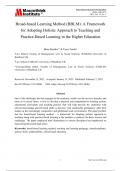International Journal of Education
ISSN 1948-5476
2023, Vol. 15, No. 1
Broad-based Learning Method (BBLM): A Framework
for Adopting Holistic Approach to Teaching and
Practice-Based Learning in the Higher Education
Brian Ikejiaku1,* & Tuiya Tembo2
1
Law School, Faculty of Management, Law & Social Sciences (FoMLSS) University of
Bradford, UK
2
Law School, FoMLSS, University of Bradford, UK
*Corresponding author: Faculty of Management, Law & Social Sciences (FoMLSS)
University of Bradford, UK
Received: November 11, 2022 Accepted: January 13, 2023 Published: February 7, 2023
doi:10.5296/ije.v15i1.20463 URL: https://doi.org/10.5296/ije.v15i1.20463
Abstract
One of the challenges that has engaged in the academic world over the last two decades, and
more so in recent times, is how to develop a practical and comprehensive learning system,
educational curriculum and teaching practice that will help provide the student(s) with
relevant knowledge and all-round skills, to become ‘real employable graduate(s)’ after their
studies in the increasingly competitive and globalised work environment. The paper proffers
that the broad-based learning method – a framework for adopting holistic approach to
teaching along with practice-based learning is the antidote or panacea for these worries and
challenges. The paper employed brief illustrations in various disciplines but emphasised on
legal and professional legal clinic.
Keywords: broad-based learning method, teaching and learning pedagogy, interdisciplinary,
generic skills, employability, clinical legal education
1 http://ije.macrothink.org
, International Journal of Education
ISSN 1948-5476
2023, Vol. 15, No. 1
1. Introduction
Faculties globally are faced with determining how to develop academic curriculum and
present course materials so that students not only gain knowledge of the discipline, but also
become self-directed learners who develop relevant skills they can apply in their future
careers. The broad-based method as educational practice takes a holistic and comprehensive
approach to teaching and learning. Broad based methods do not agree with the assumption
that various important aspects of benefits that could be acquired from the pursuit of graduate
studies, such as academic knowledge, civility, transferable skills, and others cannot be
possible because there is no single available teaching and learning method or technique to
achieve this. The paper proffers that the broad-based learning method – a framework for
adopting a holistic approach to teaching and practice-based learning is a keyway that has
strived to achieve this. The paper employed brief illustrations in various disciplines but
emphasised on legal and professional legal clinic.
1.1 What Broad Based Methods Involves or Does Not Involve
While broad-based method could be framed within the context of orthodox learning
pedagogy; it does not involve splitting the curriculum into different segments of learning and
teaching practice. It is basically an approach which is more about learning to learn, which
emphasises on learning through experiment, practical exercise, and experience. Thus, by
employing the method, the students are encouraged to try things to prove to themselves what
works, rather than be told. The students are also encouraged to engage in group work learning
activities. (Note 1)
2. Benefits of Broad-Based Methods
Contrary to educational techniques that adopt teaching and learning pedagogical practice
which lays emphasis on the students gaining the theoretical knowledge and principles in the
various fields of their studies; the broad-based method emphasises on the students not only
gaining this, but also to acquire transferable skills that are extremely vital for the students’
employability after graduation. In this respect, broad based educational curriculum integrates
work-based learning (WBL) into the teaching and learning curriculum.
It accepts the approach of combining different teaching and learning pedagogies, as a
technique for achieving positive or successful learning outcomes. For example, broad-based
method allows the Teacher a combination of teaching pedagogies such as, student/learner-
centred, (note 2) problem-based, (note 3) teacher-centred (note 4), research-led (note 5) etc,
with the aim of delivering an outstanding teaching and learning. The use of broad-based
method gives room for inspirational and innovative teaching and learning, including
stimulating and promoting effective teaching and learning among diverse and challenging
learners; as well as challenging ideas, fostering debate, inspiring, and encouraging students to
develop skills in critical discourse and rational thinking to improve their academic standards.
It involves teaching in a range of contexts: individual, small/large groups, lab classes and
auditorium, and through combination of methods: lectures, tutorials, coursework, seminars,
2 http://ije.macrothink.org




